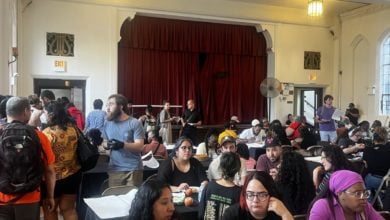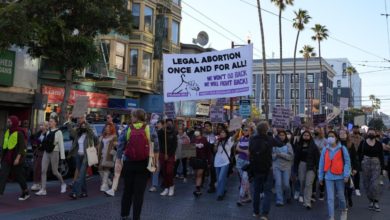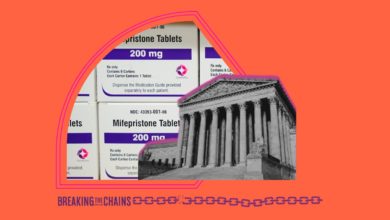In 2019 so far, 15 states have introduced so-called “heartbeat” bills which ban all or almost all abortions after 6 weeks of gestation. These states include Florida, Georgia, Illinois, Kentucky, Louisiana, Maryland, Minnesota, Mississippi, Missouri, New York, Ohio, South Carolina, Tennessee, Texas, and West Virginia which have introduced measures to ban abortion as early as six weeks into a pregnancy.
In the past two months, these abortion bans have been passing quickly in a number of states. Between March 15 and May 17, abortion bans have passed in Kentucky, Mississippi, Ohio, Georgia, Missouri, Louisiana, South Carolina and Alabama. Alabama passed the most stringent bill, with an almost total ban on abortion after 8 weeks. (Rewire.News)
It is important to note that these laws are being challenged and abortion remains legal in all these states.
The term “heartbeat” in the names of the bills is misleading. There is no heartbeat at 6 weeks of gestation. As Rewire.News Denny Carter recently wrote, “at six weeks’ gestation, there is no heart, there is no heartbeat, and there is no fetus. Instead, there is a ‘fetal pole,’ a thick area alongside the yolk sac that extends from one end of an embryo to the other. What can be measured in six weeks is electrical activity in that pole.” At six weeks gestation, most do not even know they are pregnant and thus, a six or even eight week ban is in effect, a total ban on abortion.
Anti-abortion strategies involved in the passage of these bills
For a number of years, the anti-abortion movement’s legislative wing focused on passing what are known as “targeted restrictions on abortion providers.” These TRAP laws imposed medically unnecessary requirement on outpatient abortion clinics, putting many of them out of business. At the same time, it became harder and harder for women to have abortions in hospitals, as secular private hospitals were bought by Catholic Church affiliated chains. These conditions have created a de-facto ban on abortion in some states by making it very hard for women to actually access a legal medical procedure.
Now, with the shift in composition of the Supreme Court, (caused by the appointment of accused rapist Brett Kavanaugh) the forces opposed to women’s bodily autonomy have their sights set on overturning Roe v. Wade, the landmark 1973 Supreme Court decision that determined that abortion was a private decision to be made between a woman and her doctor.
The six-week bans are part of this strategy. Each one is being challenged in court. The anti-abortion movement hopes that one of these cases will make it to the Supreme Court and lead to the overturning of Roe.
The issue of abortion is a primary one for women’s equality. Without access to effective birth control and to abortion, women cannot participate as equals in society, relegated instead to the role of human incubators. The reality is that making abortion illegal will not end abortion. It will simply end legal abortion. Women have always sought to end unwanted pregnancies and they always will. The difference is that a legal abortion performed by a qualified medical professional is one of the safest medical procedures around — fraught with far fewer dangers than carrying a pregnancy to term and delivering a baby.
If women are people, they must have the right to bodily autonomy. Women should not be forced to carry a pregnancy any more than they should be forced to end a pregnancy. Women being seen and treated as primarily a vessel for the creation of a new generation — not as humans with rights independent of our ability give birth — is the product of patriarchal society.
Overturn the Hyde Amendment
These six and eight-week abortion bans, if upheld, would have a more severe impact on poor, working class women, especially women of color. This is because women with greater financial resources will (despite possible legal risks) be able to take time off from work and travel to other states in order to obtain abortions, or perhaps access higher quality illegal abortions in their own states, again despite legal and health risks. Poor and oppressed women will be left with the choice of an illegal and dangerous “do it yourself” abortion or forced childbirth with the attendant risks of either option.
Even with legal abortion under Roe, access to abortion for poor women has been limited since 1976, when the Hyde Amendment was first passed by Congress which banned the use of federal funding to pay for abortions through Medicaid unless necessary to save the woman’s life. Later exceptions were generously extended to include paying for abortion in cases of rape or incest. The ban on federal funding for abortion was carried into the Affordable Care Act.
The Hyde amendment has been reauthorized annually since it was first passed. To understand the scope of the impact, Medicaid currently serves approximately 15.6 million women in the United States, including 1 in 5 women of reproductive age (women aged 15–44).“ The Hyde Amendment restricts abortion coverage for federally-funded healthcare recipients, specifically women enrolled in Medicare and Medicaid, Native American women, U.S. servicewomen and veterans, women in Peace Corps, female federal employees, D.C. women residents, and women in immigration detention facilities and prisons.” (Wikipedia)
“[The] Hyde Amendment disproportionately affects low-income women, as an estimated 42% of abortion recipients live below the poverty line.[18] Since the passage of the Hyde Amendment, more than one million women have not been able to afford abortions and so have had to carry unwanted pregnancies to term. 18 to 33 percent of Medicaid-eligible women who want abortions have been forced to give birth because they live in states that do not provide funding.” (Wikipedia)
Racist impact of abortion ban
As can be seen, poor women and especially women of color will be disproportionately impacted by a ban on abortion, despite already facing severe hurdles to abortion access due the Hyde Amendment. In addition, Black women in particular face a special threat. The statistics on maternal mortality for Black women in the U.S. are astoundingly bad. “Black women are three to four times more likely to experience a pregnancy-related death than white women.” While the solution to the maternal mortality crisis goes far beyond protecting access to abortion, abortion’s availability remains a necessary though not sufficient condition for protecting the health of all women and reducing maternal deaths. Forcing more Black women to carry unwanted pregnancies to term can only intensify this crisis.
Any ban on abortion would also potentially impact transgender men. The same forces that oppose women’s right to abortion oppose the very existence of and equal rights for transgender people. Abortion bans impact anyone who can get pregnant; i.e. those with a uterus and ovaries. The thrust of this particular reactionary attack is not however primarily anti-trans but misogynist — to drive women back to the bad old days. Regardless of one’s gender identity or expression, the attempt to ban abortion is an attack on anyone who refuses to allow biology to be destiny.
In fact, these laws, and the drive to overturn Roe, are an attack on the entire working class, attempting to make the lives of working class women — about 50 percent of our class — even more precarious than they already are.
A socialist program for the United States includes full access to abortion on demand as part of a comprehensive universal health care system. Socialism also means that housing, living wage employment and education — including day care — would be human rights. This would give all women a real choice about whether or not to have children.
Strategy to defend abortion rights
The right to safe legal abortion in the United States was one of the major victories of so-called Second Wave feminism. Donna Goodman in her book “Women fight back: the centuries-long struggle for liberation” describes the movement that led to Roe. During the Second Wave, the legalization of abortion was first advocated in 1969 by socialist feminist collective Redstockings who held the first speak-out on abortion.
“At first only the most radical feminists raised the issue, but soon liberal feminists joined in as well. A broad section of women began to demand access to safe, legal abortion as a key element of equality and freedom.
“Advocates of legal abortion conducted marches, demonstrations at medical conventions, and sit-ins at hospitals. Feminists in Chicago organized an underground abortion service called ‘Jane’ that arranged for more than 11,000 abortions ‘with a safety record that rivaled private clinics.’
“Lawsuits challenging anti-abortion laws were filed in several states, and radical feminists played an important role in finding plaintiffs. … Ultimately a case brought by a plaintiff using the name Jane Roe to challenge a Texas law outlawing abortion was appealed to the Supreme Court. In 1973 the Court handed down a decision in Roe v. Wade that protected a woman’s right to an abortion in the early stages of pregnancy, before the viability of the fetus, using the right to privacy that was affirmed in the 1965 Griswold decision. …
“The Supreme Court was not full of feminists when it issued its Roe ruling. In fact, it was generally reactionary and conservative. It was a sign of the movement’s strength, the pressure from below that had resonated through and shaken all of society.”
This history should be instructive to us today. The abortion ban laws must, of course, be challenged in court. But our struggle cannot stop at the courthouse door. The broader movements for women’s equality, for reproductive and gender justice, must engage in mass mobilization on the streets. This is what is missing in today’s context.
Public opinion
A quick perusal of public opinion on abortions indicates a strong divide between those who support access to abortion and those who oppose it. We can quibble with the way the question has been framed over the course of historic Gallup polls, but as of July 2018, 64 percent of those polled opposed the overturning of Roe. In May 2018, 29 percent thought that abortion should be legal under all circumstances and 50 percent thought it should be legal but only under some circumstances. A further breakdown showed that 14 percent thought abortion should be legal under most circumstances; 35 percent believed it should be legal only under a few circumstances. Only 18 percent believed it should be illegal under all circumstances. Interestingly, in the same poll, 48 percent identified as “pro-life” and 48 percent identified as “pro-choice,” showing the meaninglessness of these terms.
Women in Poland defeat abortion ban in 2016
In 2016, the women of Poland successfully defeated an attempt to ban abortion through mass mobilizations.
Clearly, there are many differences between Poland and the United States. That said, there are also some important lessons to be learned from the Polish experience as outlined in Paweł Szelegieniec’s informative article “Behind the ‘Black Protests’: The Struggle for Abortion Rights in Poland”, such as:
- The extent of the extremist, fascist roots of the anti-abortion movement in Poland. Similarly in the United States, and we are now seeing a cross-pollination of so-called “alt-right” forces into the anti-abortion movement, with groups like Proud Boys joining in to harass clinic defenders at Planned Parenthood.
- The impact of mass mobilization, even by a vocal minority, on public opinion.
- The decisive role of mass mobilization on policy decisions despite mixed public opinion.
We cannot simply wait for appeals to grind through the courts, despite some promising decisions such as the Kansas State Supreme Court’s April 26 ruling that abortion is a right under the state constitution. In Kansas, the right’s response to that decision has been a new move to amend the state constitution to in effect ban abortion. (KSNT.com) Nor should we tie the movement to defend abortion to the Democratic Party. This is not an ultra-left position. It is deeply practical and based in historical analysis.
![Polish "Black March" in support of abortin rights. Zorro2212 [CC BY-SA 4.0 (https://creativecommons.org/licenses/by-sa/4.0)]](https://www.liberationnews.org/wp-content/uploads/2019/05/Black_March_in_support_of_abortion_rights_Łódź_October_2nd_2016_33-300x201.jpg)
The mainstream feminist movement has tied its fate to the Democrats, converting mass pro-choice rallies into pro-Democrat election rallies. This strategy has not succeeded, leading us to where we are today, contemplating the overturning of Roe. Now that this ineffective strategy has brought us here, the best the Democrats can do today is work to pass laws at the state level to cement abortion rights in place in individual states in the event Roe is overturned. But this state-by-state defensive action hardly provides a solution to the looming crisis.
Socialist feminists have to work with what we have right now, which is a society in which a majority oppose overturning Roe and support legal abortion in all or some circumstances. Without conceding an inch to reactionary notions about when abortion should not be allowed, we must unite with all who defend safe and legal abortion, and continue to agitate for a socialist program on gender equality that defends the bodily autonomy of all humans and a healthcare program that includes abortion on demand as one component of comprehensive universal health care. Stop the war on women!






